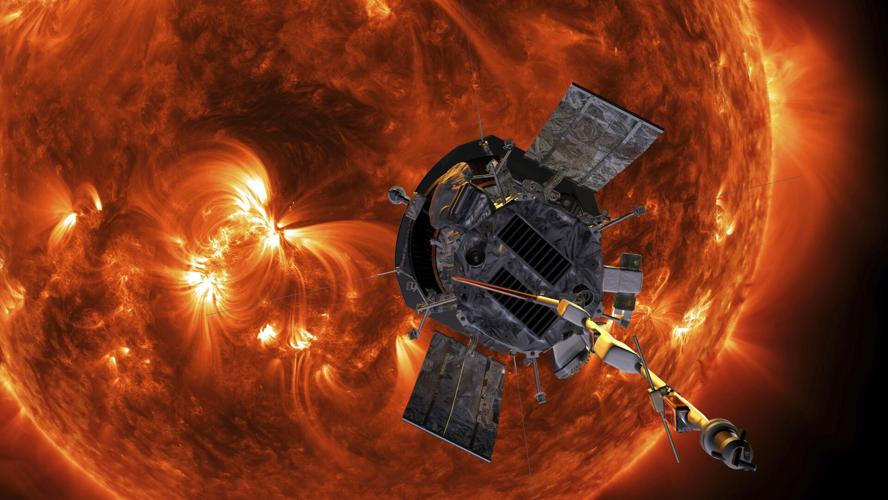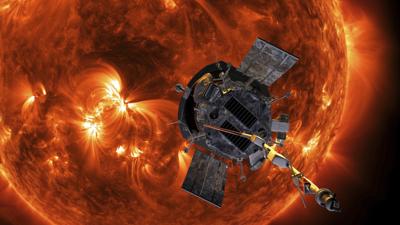NASA has just released the closest-ever images of the sun, captured by its Parker Solar Probe on its record-breaking flyby into the outermost layer of the star’s atmosphere late last year.
The images were taken some 6.1 million kilometres from the sun’s surface and reveal solar winds raging within the sun’s corona — offering scientists new insight into the star’s influence on the solar system and Earth.
“We are witnessing where space weather threats to Earth begin, with our eyes, not just with models,” said Nicky Fox, associate administrator, Science Mission Directorate at NASA Headquarters in Washington, D.C., .
“This new data will help us vastly improve our space weather predictions to ensure the safety of our astronauts and the protection of our technology here on Earth and throughout the solar system.”
The images released by NASA were taken some 6.1 million kilometres from the sun's surface and reveal solar winds raging within the sun's corona.
NASAWhat am I looking at?
The images capture multiple coronal mass ejections (CME) — enormous eruptions containing billions of tons of magnetized plasma — colliding with one another after bursting in close succession. It is the first time such a phenomenon has been captured in high resolution.
These eruptions can be felt from Earth. When energy transfers to Earth’s surrounding space environment and collide with the planet’s magnetic field, it can cause a geomagnetic storm — generating currents capable of damaging Earth-bound power grids and communication networks, and sparking aurora borealis, also known as the northern lights.
The new images, which reveal the sun’s heliospheric current sheet — the boundary in the sun’s atmosphere where the star’s magnetic field switches direction from northward to southward — allow researchers a closer look at what happens to the solar ejections right after they’re released from the corona, according to NASA.
“In these images, we’re seeing the CMEs basically piling up on top of one another,” said Angelos Vourlidas, the WISPR instrument scientist at the Johns Hopkins Applied Physics Laboratory, which designed, built, and operates the spacecraft. “We’re using this to figure out how the CMEs merge together, which can be important for space weather.”
WISPR, or the Wide-Field Imager for Solar Probe, was the instrument aboard the Parker probe that captured the images.
Stargazers might recall a similar multi-ejection event in May of last year, which led to spectacular northern lights across much of Canada. That event was the result of at least five simultaneous coronal mass ejections, and it temporarily knocked down communications from some commercial satellites.
According to NASA, when CMEs collide, their trajectories can change, complicating predictions of where they’ll end up. Collisions can also accelerate charged particles and mix magnetic fields, posing a potential risk to astronauts and satellites in space.

 NASA’s Parker Solar Probe captured multiple coronal mass ejections colliding during its record-breaking fly-by into the sun’s outermost atmosphere.
NASA/Johns Hopkins APL/Naval ResWhat is solar wind?
Solar wind is the constant stream of electrically charged particles launched from the sun and across the solar system, at speeds exceeding a million miles an hour.
Before the Parker probe, scientists had to observe the phenomenon from a distance. Since its launch in 2018, its closer look at the sun has helped uncovered new revelations, from zigzagging magnetic fields known as switchbacks to the further insight into the two main types of solar wind: slow and fast.
Last year, scientists announced these switchbacks partially powered the two classes of solar winds. The interplay between slow and fast solar wind is capable of creating solar storm conditions on Earth, sometimes rivalling that of CMEs.

NASA’s Parker Solar Probe captured multiple coronal mass ejections colliding during its record-breaking fly-by into the sun’s outermost atmosphere.Â
NASA/Johns Hopkins APL/Naval ResThe Park probe will continue to gather data as it orbits the sun, which will help scientists unravel the origins of slow solar wind. Its next pass into the sun’s corona is scheduled for Sept. 15.
“The big unknown has been: how is the solar wind generated, and how does it manage to escape the Sun’s immense gravitational pull?” said Nour Rawafi, the project scientist for Parker Solar Probe at the Johns Hopkins Applied Physics Laboratory.Â
“Understanding this continuous flow of particles, particularly the slow solar wind, is a major challenge, especially given the diversity in the properties of these streams — but with Parker Solar Probe, we’re closer than ever to uncovering their origins and how they evolve.”




























